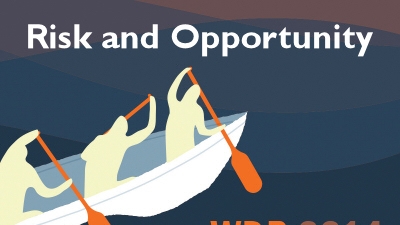Oct 6, 2013, Washington, D.C. -- In recent years, the world has faced multiple risks that have both disrupted the global economy and threatened lives, assets, and social cohesion in many countries.
The latest World Development Report (WDR), Risk and Opportunity: Managing Risk for Development, analyzes risk at many levels and forms and is rich with examples, ranging from job loss and disease to financial crises and natural disasters—often highlighting the costly consequences of mismanaged risk. The 147 banking crises that have struck 116 countries in the past 40 years, for instance, have led to large declines in output and employment.
Poor people in developing countries tend to be hit the hardest by risks because the resources they have to manage risks are often meager or non-existent. More people die from drought in Africa than any other natural hazard whereas virtually no one has died from drought in developed countries in the past four decades. Without improved risk management, the fight to end poverty will be even more elusive, says the report.
A key message from the WDR 2014 is that risk management can be a powerful tool for development and has the potential to bring about security and future prosperity to people in the developing world. Effective risk management approaches can not only protect the poor – they can also unlock opportunities for better development outcomes. For example, farmers in Ghana and India – among other countries – who have rainfall insurance have increased their investments in fertilizer, seeds, and other inputs.
Stressing the need to shift from ad hoc responses when crises occur to a more proactive, systematic and integrated risk management, the report strongly affirms the truth in the old adage, ‘an ounce of prevention is worth a pound of cure’. For example, in the past four decades, Bangladesh has faced three cyclones, each claiming thousands of lives. However, over the years, casualties have been greatly reduced – from 300,000 lives in 1970 to 4,000 in 2007. This was due to the implementation of a nationwide program to build shelters along with the introduction of improved forecasting capacity and a relatively simple but effective public alert system.
Even when risk management is cost-effective and saves lives, individuals and societies struggle to manage risk due to obstacles and constraints such as lack of information and resources, cognitive and behavioral failures, missing markets and public goods, and unintended social and economic consequences. For example, simple steps to prevent the spread of diseases, such as washing hands and wearing face masks, are effective but often not implemented. Thus, identifying risks is not enough: the trade-offs and obstacles of risk management must also be identified, prioritized and addressed through public and private action.
"This World Development Report shows human decision-making falters most where risk is involved – for this reason, risk creates special challenges for development policy. As globalized nations contend with fluctuations between good and bad outcomes, there is at times a propensity to shy away from development and globalization, when in fact doing so is to opt for the bad outcome in perpetuity,” says Kaushik Basu, World Bank Chief Economist and Senior Vice President.

